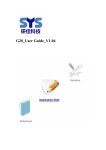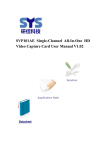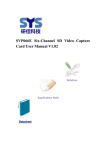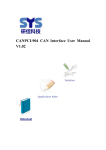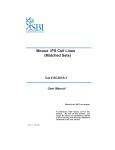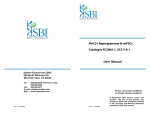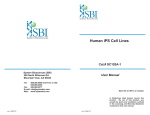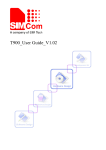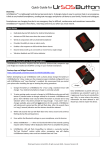Download G10_User Guide_V1.0
Transcript
G10_User Guide_V1.0 www.sysembed.com Document Title: G10_User Guide_V1.0 Version: 1.0 Date: 2013-5-20 Status: Release Document Control ID: G10_User Guide_V1.0 General Notes SYSTECH offers this information as a service to its customers, to support application and engineering efforts that use the products designed by SYSTECH. The information provided is based upon requirements specifically provided to SYSTECH by the customers. SYSTECH has not undertaken any independent search for additional relevant information, including any information that may be in the customer’s possession. Furthermore, system validation of this product designed by SYSTECH within a larger electronic system remains the responsibility of the customer or the customer’s system integrator. All specifications supplied herein are subject to change. Copyright This document contains proprietary technical information which is the property of SYSTECH copying of this document and giving it to others and the using or communication of the contents thereof, are forbidden without express authority. Offenders are liable to the payment of damages. All rights reserved in the event of grant of a patent or the registration of a utility model or design. All specification supplied herein are subject to change without notice at any time. Copyright © Systech 2012 G10_User Guide_V1.0 2 2013-5-20 www.sysembed.com Version History Version Chapter What is new V1.0 New Version Monya G10_User Guide_V1.0 3 2013-5-20 www.sysembed.com Contents 1 Introduction ...........................................................................................................7 2 Interface Introduction .............................................................................................8 2.1 2.2 2.3 2.4 2.5 3 Quick start ...........................................................................................................12 3.1 3.2 4 Setting up the modem ........................................................................................................ 12 Check the communication with the modem....................................................................... 12 Electrical,Reliability and Radio Characteristics .......................................................13 4.1 4.2 4.3 4.4 4.5 5 Power supply connector ....................................................................................................... 8 DB9 connector ..................................................................................................................... 9 SMA connector .................................................................................................................. 10 GPRS status LED............................................................................................................... 11 SIM card holder ................................................................................................................. 12 Absolute maximum ratings ................................................................................................ 13 Recommended operating conditions .................................................................................. 13 Electro-Static discharge ..................................................................................................... 13 Operating frequency........................................................................................................... 13 Transmitter output power and receiver sensitivity ............................................................. 14 Package content ....................................................................................................14 Appendix...................................................................................................................15 A. Related Documents................................................................................................................ 15 B. Terms and Abbreviations...................................................................................................... 15 C. Safety Caution........................................................................................................................ 17 G10_User Guide_V1.0 4 2013-5-20 www.sysembed.com Table Index TABLE 1: G10 key features.............................................................................................................. 6 TABLE 2: The consumption in sleep mode ...................................................................................... 9 TABLE 3: 9-pole D-sub (female) RS232.......................................................................................... 9 TABLE 4: Antenna specifications................................................................................................... 11 TABLE 5: Status of the NETLIGHT indicator (Green) .................................................................. 11 TABLE 6: Absolute maximum ratings............................................................................................ 13 TABLE 7: Recommended operating conditions ............................................................................. 13 TABLE 8: The ESD characteristics (Temperature: 25℃, Humidity: 45%) .................................... 13 TABLE 9: Operating frequency ...................................................................................................... 14 TABLE 10: Transmitter output power and receiver sensitivity....................................................... 14 TABLE 11: Related documents....................................................................................................... 15 TABLE 12: Terms and abbreviations.............................................................................................. 15 TABLE 13: Safety caution.............................................................................................................. 17 G10_User Guide_V1.0 5 2013-5-20 www.sysembed.com Figure Index FIGURE 1: G10 overview ................................................................................................................ 6 FIGURE 2: Interface overview ......................................................................................................... 8 FIGURE 3: DB9 connector............................................................................................................... 9 FIGURE 4: COM port properties of the hyper terminal ................................................................. 10 FIGURE 5: Antenna interface......................................................................................................... 10 FIGURE 6: Indicator LED.............................................................................................................. 11 FIGURE 7: SIM card holder........................................................................................................... 12 G10_User Guide_V1.0 6 2013-5-20 www.sysembed.com 1 Introduction This document describes features, functions and interfaces of G10 modem in great detail. G10 is a Quad-band GSM/GPRS modem that works on frequencies of GSM 850MHz, EGSM 900MHz, DCS 1800MHz and PCS 1900MHz, which is a ideal solution for wireless M2M application, the modem features GPRS multi-slot class 10/8(optional) and supports the GPRS coding schemes CS-1, CS-2, CS-3 and CS-4. With the help of this document user can understand G10 interface specifications, electrical and mechanical quickly. Figure 1: G10 overview Note: The G10 Modem is fully complying with RoHS requirements of European standards. Table 1: G10 key features Feature Implementation Power supply 5V ~ 16V G10_User Guide_V1.0 7 2013-5-20 www.sysembed.com Frequency bands ● G10 Quad-band: GSM 850, EGSM 900, DCS 1800, PCS 1900. G10 can search the 4 frequency bands automatically. The frequency bands also can be set by AT command “AT+CBAND”. ● Compliant to GSM Phase 2/2+ Transmitting Power ● ● Class 4(2W) at GSM 850 and EGSM 900 Class 1(1W) at DCS 1800 and PCS 1900 GPRS connectivity ● ● GPRS multi-slot class 10 (default) GPRS multi-slot class 8 (option) Temperature range ● ● ● Normal operation: -20℃~+70℃ ﹡ Restricted operation: -30℃~-20℃ and +70℃~+75℃ Storage temperature: -45℃~+90℃ Data GPRS ● ● ● ● ● GPRS data downlink transfer: max.85.6kbps GPRS data uplink transfer: max.42.8kbps Coding scheme: CS-1, CS-2, CS-3 and CS-4 Integrate the TCP/IP protocol Support Packet Broadcast Control Channel (PBCCH) CSD ● Support CSD transmission USSD ● Unstructured Supplementary Services Data (USSD) support SMS ● ● MT, MO, CB, Text and PDU mode SMS storage: SIM card FAX Group 3 Class 1 SIM interface Support SIM card: 1.8V, 3V External antenna SMA type RF connector RS232 serial port Serial port ● Full modem interface with status and control lines, unbalanced, asynchronous. ● 1200bps to 115200bps. ● Can be used for AT commands data stream. ● Support RTS/CTS hardware handshake and software flow control. ● Multiplex ability according to GSM 07.10 Multiplexer Protocol. ● Autobauding supports baud rate from 1200 bps to 57600 bps. SIM Toolkit GSM 11.14 Release 99 Physical characteristics Size: 110*54*25mm Weight: 120g Firmware upgrade Firmware upgradeable by RS232 interface ﹡ G10 does work at this temperature, but some radio frequency characteristics may deviate from the GSM specification. G10_User Guide_V1.0 8 2013-5-20 www.sysembed.com 2 Interface Introduction Figure 2: Interface overview 2.1 Power supply connector Customer can use the DC adapter that SYSTECH provides as the power source. If customer does not use the adapter, then DC source should be satisfied with the following requirements. ● Input voltage range 5~16V ● Normal voltage 6V ● Current ability 2A G10_User Guide_V1.0 9 2013-5-20 www.sysembed.com Table 2: The consumption in sleep mode G10 @5V @12V @15V Sleep current 14.5mA 7.75mA 5.02mA 2.2 DB9 connector G10 provides one asynchronous RS232 serial port (female). The RS232 standard interface serves to connect a PC, Data Terminal Equipment (DTE) or other application, which acts as host controller of the G10 modem with all its functions. Through the RS232 interface it can be used as GSM/GPRS modem for sending and receiving of SMS, Data and Fax calls. Figure 3: DB9 connector Table 3: 9-pole D-sub (female) RS232 Pin no. Signal name I/O Function 1 DCD O Data Carrier Detected 2 RXD O Receive Data 3 TXD I Transmit Data 4 DTR I Data Terminal Ready Attention: The ignition of G10 modem is activated via a rising edge of high potential (+3 … +15V) 5 GND - Ground 6 DSR O Data Set Ready 7 RTS I Request To Send 8 CTS O Clear To Send 9 RI O Ring Indication Note: G10 supports autobauding, autobauding allows G10 to automatically detect the baud rate of the host device. User can use AT command “AT+IPR=x” to set a fixed baud rate and the setting will be saved to non-volatile flash memory automatically. After the configuration is set as fixed baud rate, the URC such as “RDY”, “+CFUN: 1” and “+CPIN: READY” will be reported when G10 is powered on. G10_User Guide_V1.0 10 2013-5-20 www.sysembed.com Hyper terminal usually as the PC software tool to operate G10; customer can set up a connection between PC and modem, configure the port properties as the figure 4 shows. Figure 4: COM port properties of the hyper terminal 2.3 SMA connector Antenna connector allows transmission of radio frequency (RF) signals between the modem and the external supplied antenna. The G10 modem is fitted with a 50Ω male SMA connector. Figure 5: Antenna interface The antenna is a very important component in the system. Since the antenna transmits and G10_User Guide_V1.0 11 2013-5-20 www.sysembed.com receives electromagnetic signal, and its efficiency depends on the antenna’s type, placement and the environment of the antenna operating. The recommended antenna specifications are showed in Table 4: Table 4: Antenna specifications Frequency range GSM 850/900/1800/1900 MHz Impedance 50 ohm Input power >33dBm (2W) peak power in GSM VSWR recommended ≤2:1 VSWR absolute max ≤10:1 Gain ≤3dBi The antenna performance is very easily influenced by other electronic devices. So the antenna placement should be considered carefully as follow. 1. Place away from other electronic devices or other antennas. 2. Place far away from metal material. 3. Face the base station antenna directly if the signal strength is very weak. 2.4 GPRS status LED A green led indicates the modem status and GSM net status, after the modem been powered up and registered to the network, it will blink at a certain frequency. Figure 6: Indicator LED Table 5: Status of the NETLIGHT indicator (Green) Status G10 behavior Off G10 is not running 64ms On/ 800ms Off G10 not registered the network 64ms On/ 3000ms Off G10 registered to the network 64ms On/ 300ms Off GPRS communication is established G10_User Guide_V1.0 12 2013-5-20 www.sysembed.com 2.5 SIM card holder The SIM interface complies with the GSM Phase 1 specification and the new GSM Phase 2+ specification for FAST 64 kbps SIM card. Both 1.8V and 3.0V SIM card are supported. The SIM interface is powered from an internal regulator inside the modem. Figure 7: SIM card holder 3 Quick start 3.1 Setting up the modem To set up the modem, do the following: ● Press SIM card holder ejector (yellow button) with a sharp object. ● Insert the SIM card in the holder. ● Verify the SIM card fits in the holder properly. ● Connect the GSM/GPRS antenna to the SMA connector. ● Connect both sides of the serial cable (9-pin Sub HD connector on the modem side). ● Connect the power supply to the power supply source. ● Plug the power supply cable into the modem and switch on the external power supply. ● Now the modem is ready to work. The GPRS status LED begin to ON and flash. 3.2 Check the communication with the modem ● Connect the RS232 link between the DTE (port COM) and the modem (DCE). ● Configure the RS232 port of the DTE as follows ◇ Bits per second: 115200 bps ◇ Data bits: 8 ◇ Parity: None ◇ Stop bits: 1 ◇ Flow control: Hardware Flow control ● Using a communication software such as Hyper Terminal program, enter the AT command. The response of the modem must be OK displayed in the Hyper Terminal window. G10_User Guide_V1.0 13 2013-5-20 www.sysembed.com 4 Electrical, Reliability and Radio Characteristics 4.1 Absolute maximum ratings The absolute maximum ratings stated in following table are stress ratings under non-operating conditions. Stresses beyond any of these limits will cause permanent damage to G10. Table 6: Absolute maximum ratings Symbol Parameter Min Typ Max Unit VBAT Power supply voltage 4.5 - 16 V VI* Input voltage -0.3 - 3.1 V * Input current - - 10 mA Output current - - 10 mA II IO* * These parameters are for digital interface pins, such as UART, DEBUG. 4.2 Recommended operating conditions Table 7: Recommended operating conditions Symbol Parameter Min Typ Max Unit VBAT Power supply voltage 5 6 16 V TOPER Operating temperature -30 +25 +75 ℃ TSTG Storage temperature -45 +90 ℃ 4.3 Electro-Static discharge G10 is an ESD sensitive component, so more attention should be paid to the procedure of handling and packaging. The ESD test results are shown in the following table. Table 8: The ESD characteristics (Temperature: 25℃, Humidity: 45%) Test item Contact discharge Air discharge Shell ±10KV ±15KV RF interface ±10KV ±15KV RS232 interface ±10KV ±15KV SIM card holder ±10KV ±15KV 4.4 Operating frequency G10_User Guide_V1.0 14 2013-5-20 www.sysembed.com The operating frequencies in GSM850, EGSM900, DCS, PCS modes are conform to the GSM Specifications, shown as bellow. Table 9: Operating frequency Mode GSM-850 Freq.TX(MHz) Freq.RX(MHz) Channels(A RFC) TX-RX offset 824-849 869-894 128-251 45MHz 890-915 935-960 0-124 45MHz 880-890 925-935 975-1023 45MHz DCS-1800 1710-1785 1805-1880 512-885 95MHz PCS-1900 1850-1910 1930-1990 512-810 80MHz EGSM-900 4.5 Transmitter output power and receiver sensitivity The G10’s conducted transmitter output power and receiver sensitivity are shown as bellow: Table 10: Transmitter output power and receiver sensitivity Mode Power(dBm) Sensitivity(dBm) GSM-850 +33 -108 EGSM-900 +33 -108 DCS-1800 +30 -107 PCS-1900 +30 -107 5 Package content G10 package include: ● G10 modem: 1 PCS ● Power supply: 1 PCS ● Data cable: 1 PCS ● GSM/GPRS antenna: 1 PCS G10_User Guide_V1.0 15 2013-5-20 www.sysembed.com Appendix A. Related Documents Table 11: Related documents SN Document name SIM900_AT 1 Command Manual 2 AN_SIM900_TCPIP SIM900_Multiplexer User Manual_Application Note AN_Serial Port 3 4 SIM900_Serial Update Tool UGD ITU-T Draft new recommendation V.25ter: 5 6 7 GSM 07.07: 8 GSM 07.10: 9 GSM 07.05: 10 GSM 11.14: 11 GSM 11.11: 12 GSM 03.38: 13 GSM 11.10: Remark SIM900 AT Command Manual TCP/IP Applications User Manual SIM900 Multiplexer User Manual Application Note Application Note About Serial Port Update Tool User Manual Serial asynchronous automatic dialing and control Digital cellular telecommunications (Phase 2+); AT command set for GSM Mobile Equipment(ME) Support GSM 07.10 multiplexing protocol Digital cellular telecommunications (Phase 2+); Use of Data Terminal Equipment-Data Circuit terminating Equipment (DTE-DCE) interface for Short Message Service (SMS) and Cell Broadcast Service (CBS) Digital cellular telecommunications system (Phase 2+); Specification of the SIM Application Toolkit for the Subscriber Identity Module-Mobile Equipment (SIM-ME) interface Digital cellular telecommunications system (Phase 2+); Specification of the Subscriber Identity Module-Mobile Equipment (SIM-ME) interface Digital cellular telecommunications system (Phase 2+); Alphabets and language-specific information Digital cellular telecommunications system (Phase 2+); Mobile Station (MS) conformance specification; Part1: Conformance specification B. Terms and Abbreviations Table 12: Terms and abbreviations Abbreviation Description AT Attention commands CS Coding Scheme CSD Circuit Switched Data CTS Clear to Send DTE Data Terminal Equipment (typically computer, terminal, printer) DTR Data Terminal Ready G10_User Guide_V1.0 16 2013-5-20 www.sysembed.com DTU Data Transmit Unit DTX Discontinuous Transmission EFR Enhanced Full Rate EGSM Enhanced GSM ESD Electrostatic Discharge ETS European Telecommunication Standard FR Full Rate GPRS General Packet Radio Service GSM Global Standard for Mobile Communications HR Half Rate IMEI International Mobile Equipment Identity Li-ion Lithium-Ion MO Mobile Originated MS Mobile Station (GSM engine), also referred to as TE MT Mobile Terminated NA Not Access PAP Password Authentication Protocol PBCCH Packet Broadcast Control Channel PCB Printed Circuit Board PCL Power Control Level PCS Personal Communication System, also referred to as GSM 1900 PDU Protocol Data Unit PPP Point-to-Point Protocol RF Radio Frequency RMS Root Mean Square (value) RTC Real Time Clock RX Receive Direction SIM Subscriber Identification Module SMS Short Message Service TE Terminal Equipment, also referred to as DTE TX Transmit Direction UART Universal Asynchronous Receiver & Transmitter URC Unsolicited Result Code USSD Unstructured Supplementary Service Data phonebook abbreviations FD SIM fix dialing phonebook LD SIM last dialing phonebook (list of numbers most recently dialed) MC Mobile Equipment list of unanswered MT calls (missed calls) G10_User Guide_V1.0 17 2013-5-20 www.sysembed.com ON SIM (or ME) own numbers (MSISDNs) list RC Mobile Equipment list of received calls SM SIM phonebook NC Not connect C. Safety Caution Table 13: Safety caution Marks Requirements When in a hospital or other health care facility, observe the restrictions about the use of mobiles. Switch the cellular terminal or mobile off, medical equipment may be sensitive to not operate normally for RF energy interference. Switch off the cellular terminal or mobile before boarding an aircraft. Make sure it is switched off. The operation of wireless appliances in an aircraft is forbidden to prevent interference with communication systems. Forget to think much of these instructions may lead to the flight safety or offend against local legal action, or both. Do not operate the cellular terminal or mobile in the presence of flammable gases or fumes. Switch off the cellular terminal when you are near petrol stations, fuel depots, chemical plants or where blasting operations are in progress. Operation of any electrical equipment in potentially explosive atmospheres can constitute a safety hazard. Your cellular terminal or mobile receives and transmits radio frequency energy while switched on. RF interference can occur if it is used close to TV sets, radios, computers or other electric equipment. Road safety comes first! Do not use a hand-held cellular terminal or mobile when driving a vehicle, unless it is securely mounted in a holder for hands free operation. Before making a call with a hand-held terminal or mobile, park the vehicle. GSM cellular terminal or mobile operate over radio frequency signals and cellular networks and cannot be guaranteed to connect in all conditions, for example no mobile fee or a invalid SIM card. While you are in this condition and need emergent help, please remember using emergency calls. In order to make or receive calls, the cellular terminal or mobile must be switched on and in a service area with adequate cellular signal strength. Some networks do not allow for emergency call if certain network services or phone features are in use (e.g. lock functions, fixed dialing etc.). You may have to deactivate those features before you can make an emergency call. Also, some networks require that a valid SIM card be properly inserted in the cellular terminal or mobile. G10_User Guide_V1.0 18 2013-5-20 www.sysembed.com Contact us: SYSTECH Address: 702, Block A, Tsinghua Hi-Tech Park, Nanshan, Shenzhen, China Tel: 400-993-9390 Fax: 86-755-2603 0411 Post code: 518057 www.sysembed.com G10_User Guide_V1.0 19 2013-5-20



















